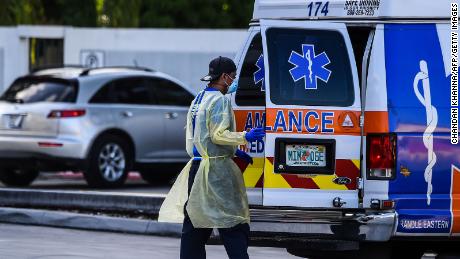But a “sharp increase” in new cases has engulfed contact tracers, leading to delays and “a backlog of positive cases that have yet to be assigned to a case investigator,” the North Dakota Department of Health said this week.
“Close contacts will no longer be contacted by public health officials; instead, positive individuals will be instructed to self-notify their close contacts and direct them to the NDDoH website, where landing pages will be created … explaining the recommended and required actions for both positive patients and close contacts.”
The North Dakota National Guard has shifted 50 soldiers from contacting close contacts to notifying people who have tested positive, the state health department said.
‘No safe period of time’ to be maskless with someone outside your bubble
Nationwide, all Americans need to double down on safety measures now that the definition of “close contacts” has expanded.
anyone you may have had brief contact with, within 6 feet, during a combined 15 minutes over the course of a day. (Previously, the CDC defined close contacts as anyone you had close encounters with for at least 15 minutes straight.)
“It reiterates the importance of everybody wearing a mask,” said Dr. Ashish Jha, dean of the Brown University School of Public Health.
Jha and other health experts say there’s nothing magical about 15 minutes, and that the public shouldn’t assume spending less time with people without masks is safe.
“There is no safe period of time to be with somebody who’s not part of your bubble if both of you are not wearing masks,” he said. “It’s really critical that people wear masks if you’re going to be with somebody for any period of time, even if it’s less than 15 minutes.”
The new CDC guidance came after researchers discovered even brief exposures (less than 15 minutes each) with an infected person nearby can silently spread coronavirus.
“A mask can protect other people from the virus-containing particles exhaled by someone who has COVID-19. As many as half of all people who have COVID-19 don’t show symptoms, so it’s critical to wear a mask because you could be carrying the virus and not know it,” the CDC said.
“While a mask provides some limited protection to the wearer, each additional person who wears a mask increases the individual protection for everyone. When more people wear masks, more people are protected.”
Where states stand now
well into the dreaded fall surge, fueled by indoor socializing, outbreaks
at schools and pandemic fatigue.
1,100 new deaths were reported Wednesday — the highest daily toll in more than a month, according to data from Johns Hopkins University.
The 31 states are reporting at least 10% more new Covid-19 cases this week compared to last week: Alabama, Alaska, Arizona, Colorado, Connecticut, Florida, Idaho, Illinois, Indiana, Kansas, Kentucky, Louisiana, Massachusetts, Michigan, Minnesota, Mississippi, Nebraska, Nevada, New Jersey, New Mexico, North Dakota, Ohio, Pennsylvania, Rhode Island, South Dakota, Texas, Tennessee, Vermont, Wisconsin, West Virginia and Wyoming.
Only Hawaii is trending in the right direction. The remaining 18 states are relatively steady.
to full capacity but with no mask requirements, reported its highest single-day increase of new cases in more than two months: 5,557 on Thursday. The statewide Covid-19 death toll rose to 16,470.
Oklahoma reported a record-high 1,628 new cases Thursday, the highest daily number of new cases since the pandemic began.
Ohio broke its record Wednesday and again Thursday, with more than 2,400 new infections reported. “Of the 10 highest days of new cases reported, eight have occurred in the past nine days,” Gov. Mike DeWine said.
And in New Jersey, Gov. Phil Murphy said Wednesday that hospitalizations were the highest they have been in three months.
Epidemiologist: ‘I don’t know what to do anymore’
It’s not just the soaring numbers of new cases that’s concerning. It’s also the rising numbers of deaths and hospitalizations — which could reduce care for patients who don’t even have Covid-19.
“Hospitals are starting to fill up,” Utah Gov. Gary Herbert said Thursday.
there weren’t enough resources available amid the growing Covid-19 surge.
Eventually, Terry was taken to a hospital that had the specialized care she needed, but her condition has gotten worse.
“We’ve seen, in the past couple of weeks, that our health care system is at capacity,” state epidemiologist Dr. Angela Dunn said.
“I don’t know what to do anymore,” she said. “I’m really not trying to scare anyone. I’m just trying to inform you of what’s going on and give you the facts.”
Herbert had one wish for the public:
“I would hope that people will take this seriously and do the best they can,” the governor said.
CNN’s Joe Sutton, Brandon Miller, Martin Savidge, Melissa Alonso, Dan Przygoda, Anna Sturla, Gisela Crespo, Tina Burnside and Kay Jones contributed to this report.







